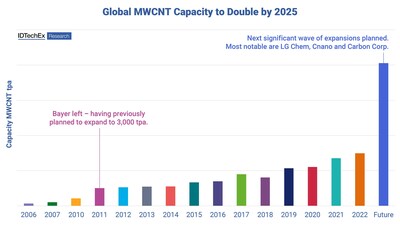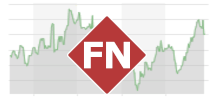BOSTON, Nov. 22, 2023 /PRNewswire/ -- Carbon nanotubes (CNTs) are gaining significant traction as a conductive additive at the cathode of lithium-ion batteries (LiB), a market driven in turn by the electrification of vehicles. This success has seen an explosion in the global production capacity of CNTs, with players racing to establish themselves as a leading supplier to the energy sector. However, the potential application areas for CNTs extend far beyond batteries. In this article, IDTechEx assesses the effects of increasing capacity and how this surge in supply will open opportunities for CNTs beyond the LiB market.

The IDTechEx report, "Carbon Nanotubes 2023-2033: Market, Technology & Players", provides a comprehensive overview of the CNT market, including an assessment of the key application areas, major players, and also includes granular 10-year market forecasts for CNT demand (tpa) and market value (US$), segmented by application areas. CNTs have seemingly found their killer application as a conductive additive in lithium-ion batteries, and IDTechEx project the market to grow in line with the booming lithium-ion battery market.
The ever-increasing demand for CNTs in the energy storage sector has translated to several large expansions in capacity by the big players in the CNT market. Cnano has a large number of notable customers, but on the other hand, LG Chem is vertically integrated. Both have announced significant expansions over the coming years alongside other players such as JEIO and Kumho Petrochemical. In particular, LG Chem is set to scale capacity from 1,700 tpa to 2,900 tpa by the end of 2023 and increase again to 6,200 tpa in 2024. New entrants to the market have announced optimistic future capacities, with Carbon Corp (C2CNT) stating plans to install a 7,500 tpa plant converting flue gas to MWCNTs.
Global MWCNT capacity to double by 2025. Source: IDTechEx
The advantageous use of CNTs in LiBs as a conductive additive has high-volume potential and will bring a number of outcomes to the CNT market, some of which have already been seen. A dramatic increase in planned capacity can be seen in the chart above, while consolidation of the market has also occurred. Major players have entered the market through strategic acquisitions such as that seen when Cabot, a major player in the carbon black market, acquired SUSN in 2021. Perhaps the most tangible outcome will be an inevitable reduction in the cost of the material and a trend towards commoditization with reduced margins. Parallels can be drawn with the carbon black industry, where profit margins of less than US$1/kg have been reported.
Approaching the concept of commoditization from another angle, this reduction in the price point of the material, coupled with expanding capacity, will inevitably open up opportunities for CNTs in markets beyond LiBs. For many of these applications, CNTs will be competing with other advanced nanocarbons, such as carbon black and graphene. Many of these opportunities are cost-sensitive and will not tolerate a premium additive, with reinforced concrete or asphalt a prime example. Tires utilize a vast quantity of carbon reinforcement on an annual basis, and despite studies that show CNTs can reduce nanoparticulate emissions, carbon black continues to dominate this space. The IDTechEx report details how CNTs will find opportunities in areas that leverage several key properties, with a notable example being in reinforced composites. By providing high mechanical strength coupled with impressive thermal conductivity, CNTs are an exciting prospect for de-icing technology built into polymer composites for use cases such as wind turbine blades or aerospace applications.
Some of the most exciting and hyped application areas for CNTs are best suited to the single walled variety (SWCNTs). The increase in sensitivity and selectivity of SWCNTs can enable next-generation technologies, including quantum computers and highly tuneable gas sensors. While the bulk of current production is focussed on multi walled CNTs (MWCNTs) for LiB applications, major players such as Cnano are pivoting into the SWCNT space and have plans for production capacity exceeding 100 tpa in the coming years. An assessment of material suppliers, including production process, targeted application areas, and a benchmarking of materials is provided in the IDTechEx market report.
It is highly likely that the success of LiBs will pave the way for the expansion of global CNT production capacity, which in turn will drive a price reduction and enable opportunities for CNTs beyond energy storage applications. Competition with alternative advanced carbon materials will be fierce, and the new report by IDTechEx lays out the suitability of each carbon material for a variety of applications, alongside an assessment of the market opportunity for CNTs in each of these applications.
For more details on the carbon nanotube market, see the IDTechEx market report "Carbon Nanotubes 2023-2033: Market, Technology & Players". For more information on this report please visit www.IDTechEx.com/CNT, or for the full portfolio of IDTechEx reports and market intelligence offerings, please visit?www.IDTechEx.com/Research.
About IDTechEx
IDTechEx guides your strategic business decisions through its Research, Subscription and Consultancy products, helping you profit from emerging technologies. For more information, contact?research@IDTechEx.com?or visit?www.IDTechEx.com.
Images download:
https://www.dropbox.com/scl/fo/f81ull4os3cytezll5evp/h?rlkey=0m6a4qwicdq3ke7tp6o25ckg5&dl=0
Media Contact:
Lucy Rogers
Marketing and Sales Administrator
press@IDTechEx.com
+44(0)1223 812300
Social Media Links:
Twitter: https://www.twitter.com/IDTechEx
LinkedIn: https://www.linkedin.com/company/idtechex/
Photo - https://mma.prnewswire.com/media/2282676/Global_MWCNT.jpg
Logo - https://mma.prnewswire.com/media/1907416/IDTechEx.jpg

![]() View original content:https://www.prnewswire.co.uk/news-releases/surging-global-carbon-nanotube-capacity-to-enable-applications-beyond-lithium-ion-batteries-finds-idtechex-301995329.html
View original content:https://www.prnewswire.co.uk/news-releases/surging-global-carbon-nanotube-capacity-to-enable-applications-beyond-lithium-ion-batteries-finds-idtechex-301995329.html



